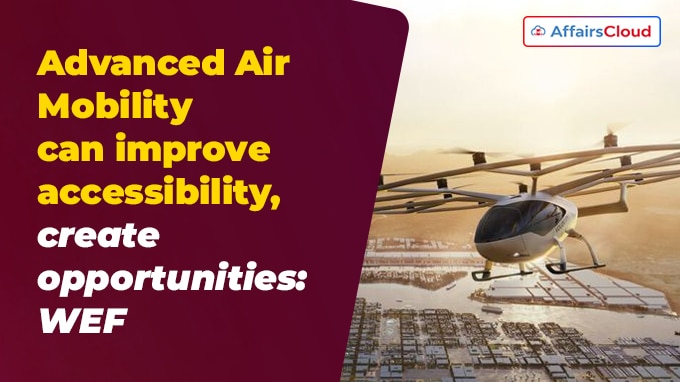
The Ministry of Civil Aviation (MoCA),Government of India(GoI), in collaboration with the World Economic Forum (WEF) has prepared the report titled ‘Skyways to the Future: Operational Concepts for Advanced Air Mobility in India‘.
- As per the report, Advanced Air Mobility (AAM) represents a transformative approach to transportation, particularly in densely populated regions like India.
- AAM solutions can significantly enhance accessibility, alleviate road congestion, and create new economic opportunities.
Highlights of the report:
i.According to the report, the sector shows strong growth, with 1,000+ aircraft and 100,000+ daily flights projected in 15 years.
ii.AAM technologies like air taxis or Electric Vertical Take-Off and Landing (eVTOL) and Short Take-Off and Landing (STOL) are designed to provide on-demand transport services.
- These innovations can help decongest urban areas by offering alternative modes of travel that bypass traditional road networks.
- AAM can provide solutions to densely populated and rapidly urbanising areas such as Mumbai, Bengaluru, Kolkata and Delhi, where traffic congestion is causing severe economic losses.
- Bengaluru alone lost almost Rs 200 billion in 2023 due to congestion, hampering productivity and worsening pollution.
iii.The report highlights that integrating AAM into India’s transport infrastructure could drive significant economic benefits, including job creation and improved access to services like healthcare.
iv.The report calls for a strong infrastructure framework with noise control, energy solutions, and community engagement to ensure AAM’s success.
v.The WEF report presents a 3-stage plan for the growth of Urban Air Mobility (UAM) in India over the next 15 years.
- The first stage focuses on a 5-year pre-operational setup, which includes creating a sandbox environment and conducting low-density commercial operations using existing helipads.
- In the intermediate stage, advanced, automated airspace management will be introduced. This will be followed by the mature stage where completely automated and autonomous, air and ground connectivity solutions would be in place.
vi.AAM could boost rural connectivity by adopting strategies like the UDAN (Ude Desh ka Aam Naagrik) scheme, subsidizing travel to underserved areas, improving access to jobs and services while ensuring operator profitability.
- Subsidies can promote the adoption of ASHA (Advanced and Short-haul Air Mobility for All) vehicles.
Points to Note:
i.India is one of the world’s fastest-growing civil aviation markets and the third largest domestic aerial market globally.
ii.India currently operates over 800 aircraft, with IndiGo holding the largest fleet.
iii.The global market size of AAM was estimated to be USD8.93 billion in 2022 and expected to reach USD 45.12 billion by 2030.
Recent Related News:
Noida, Uttar Pradesh (UP)-based Jubilant Ingrevia Limited, science products and innovative solutions provider, has become the latest Indian firm to join as a member of the Global Lighthouse Network (GLN) of the World Economic Forum (WEF).
- Jubilant Ingrevia is the only Indian firm among the cohort of 2024 welcomed by the WEF.
- In 2024, A total of 22 innovative manufacturers have joined GLN as members.
About World Economic Forum (WEF):
Founder and Executive Chairman– Prof. Klaus Schwab
Headquarters – Cologny, Switzerland
Founded – 1971




